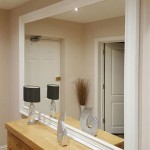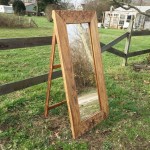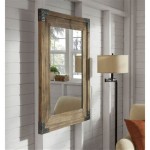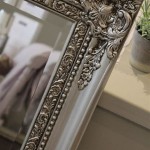Wall Mirror Art Design
Wall mirrors offer more than just a reflection; they are versatile design elements capable of transforming a space. Strategically placed and creatively designed, mirrors can enhance a room's aesthetics, manipulate light, and create an illusion of spaciousness. This article explores the fascinating world of wall mirror art design, delving into its various forms, applications, and the impact it can have on interior décor.
Shapes and Sizes: Exploring the Variety of Mirror Designs
The shape and size of a mirror significantly contribute to its artistic impact. Circular mirrors offer a soft, organic feel, contrasting with the sharp, defined lines of rectangular or square mirrors. Large, statement mirrors can serve as focal points, while smaller, intricately shaped mirrors can be arranged in clusters to create a dynamic gallery wall. Unconventional shapes, such as hexagons, octagons, or freeform designs, add a touch of uniqueness and personality to a space.
Consider the existing décor when selecting a mirror shape. A minimalist room might benefit from a sleek, rectangular mirror, while a more bohemian setting might be complemented by a round or irregularly shaped mirror. The size of the mirror should be proportional to the wall space and surrounding furniture. An oversized mirror in a small room can feel overwhelming, while a small mirror on a large wall can appear lost.
Framing and Materials: Enhancing the Mirror's Aesthetic
The frame of a mirror is an integral part of its design, adding character and enhancing its visual appeal. Frame materials range from natural wood and metal to synthetic materials like resin and plastic. A wooden frame imparts warmth and a rustic charm, while a metal frame offers a sleek, modern look. Ornate, carved frames can add a touch of elegance and sophistication, while simple, minimalist frames create a contemporary feel.
The color and finish of the frame also play a crucial role in the overall design. A metallic gold or silver frame can add a touch of glamour, while a black frame creates a bold statement. Natural wood finishes can range from light and airy to dark and rich, depending on the type of wood and stain used. The frame's design should complement the mirror's shape and the overall style of the room.
Placement and Functionality: Maximizing the Mirror's Impact
Strategic placement is key to maximizing a mirror's impact on a room. Placing a mirror opposite a window reflects natural light, brightening the space and creating an illusion of greater depth. Mirrors can also be used to highlight architectural features or artwork. Positioning a mirror above a fireplace mantel or console table draws the eye upwards and adds a touch of elegance.
Functionality should also be considered when placing a mirror. A full-length mirror in a bedroom or hallway serves a practical purpose while also contributing to the décor. Smaller mirrors in bathrooms provide essential functionality for grooming. The placement of a mirror should be both aesthetically pleasing and practical, serving its intended purpose while enhancing the overall design of the space.
Creating a Gallery Wall: A Dynamic Display of Mirrors
Grouping multiple mirrors together to create a gallery wall is a popular design trend. This approach allows for a dynamic and personalized display, combining different shapes, sizes, and frame styles to create a visually interesting focal point. A gallery wall of mirrors can add depth and dimension to a wall, particularly in smaller spaces.
When creating a gallery wall, consider the overall theme and aesthetic. Mixing and matching different styles can create an eclectic look, while sticking to a consistent theme can offer a more cohesive and unified feel. Careful planning and arrangement are essential to ensure a balanced and visually appealing composition. Experiment with different layouts before committing to a final arrangement, using paper templates to visualize the placement of each mirror.
Mirrors in Different Rooms: Tailoring the Design to the Space
The design and placement of a mirror should be tailored to the specific room and its function. In a living room, a large statement mirror can serve as a focal point, while smaller, decorative mirrors can be used to accentuate other décor elements. In a dining room, a strategically placed mirror can reflect the light from a chandelier, creating a warm and inviting ambiance. In a bedroom, a full-length mirror is essential for dressing, while smaller mirrors can be used to add a touch of personality.
Bathrooms often feature mirrors above the vanity for practical purposes, but these mirrors can also contribute to the overall design. A framed mirror adds a touch of elegance, while a frameless mirror creates a sleek and modern look. Consider the size and style of the vanity when selecting a bathroom mirror. The mirror should be proportional to the vanity and complement the overall design of the bathroom.

The Art Of Living With Exceptional Mirror Design Accent

10 Most Stylish Wall Mirror Designs To Adorn Your Modern Home Decor Bedroom Contemporary Mirrors

60 Best Wall Mirror Design Ideas Designs Decor

51 Decorative Wall Mirrors To Fill That Empty Space In Your

Metal Wall Mirror Art At Low 50 Off

51 Decorative Wall Mirrors To Fill That Empty Space In Your

Elements Mirrored Wall Art Dunelm

Reflect On This 5 Must Have Wall Mirrors Liv For Interiors

Swapnawali The Beautiful And Elegant Hand Made Lippan Art Mud Mirror Work Wall Decor

Wall Art Line Mirror 80cm X 50cm Dunelm








